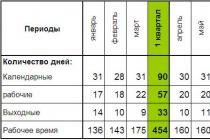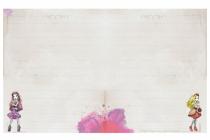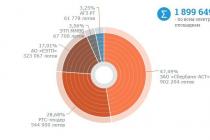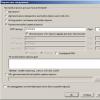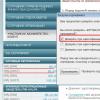With the advent of the first audio cards for personal computers it became necessary to reproduce the signal received from them. That is, small speakers were required that could be placed on the desktop (on both sides of the monitor), and that would be able to work from the line-out of sound cards. This is how multimedia acoustics was born, which over the past 15 years has gone from primitive plastic speakers to quite serious Hi-Fi systems that fully meet modern requirements for sound reproduction quality.
Multimedia speakers can be a classic stereo pair or have a satellite + subwoofer configuration. Common to multimedia speakers, in addition to size, is the presence of built-in amplifiers, as well as additional electronic circuits for sound processing. Currently, Hi-Fi acoustics for a computer / laptop are produced by many companies that have a good reputation in the market for high-class audio equipment. Hi-Fi speakers for a computer are created according to the same principles as traditional speakers - they have damped cases made of fiberboard or special non-resonant polymers, reliable amplifying circuits and sensitive speakers. Modern high-quality PC acoustics, as a rule, can also be used to reproduce sound from a TV. The functionality of multimedia acoustics is also constantly growing, it is equipped with wireless signal receivers, and special network multimedia speakers, such as or, can work in computer network(over Ethernet or Wi-Fi) and used to build multi-room systems.
Multimedia acoustics
Currently, these products are not for sale.
Reviews of multimedia acoustics
These reviews were written real buyers multimedia acoustics in our store. We do not publish the names of clients for reasons of personal data security. When buying this or that product from us, you also have the opportunity to add your review.
When a consultant advised me exactly these speakers, I thought for a long time whether it was worth taking those that are more expensive than the player itself. I took it and did not regret it. The sound is amazing! There are no low frequencies pounding on the eardrums. I'm very happy. Those who listened also appreciated the quality. Thanks for the correct advice
Fedor F. Fine
Excellent acoustics for a laptop. Very satisfied.
Good day!!! I am just delighted with this acoustics! Great sound. Immediately after registration, the manager contacted and offered to answer all the questions! Delivery was carried out within the time specified when ordering! I'm happy with everything! Thank you for your professional attitude!
Anton K. Fine
B&W MM-1 multimedia speakers not for sale
Acoustics above all praise !! For this size, just class !! All parties of instruments are distinguishable, without distortions) in general - JOY))
Andrey R. Fine
Harman Kardon Aura multimedia speakers are out of stock
the product met expectations, thank you!
As an external sound card - just great. W10 saw the device right away and immediately assigned it "the default device", no unnecessary gestures. Android also works with hardware without any problems. The speakers are small but sound great without any size discounts. And they sound great even at minimum volume. Which is important for computer acoustics. There is no background noise. Bluetooth and NFC work flawlessly. By the way, the difference between Bluetooth (even with aptX) and USB connection is unambiguous. Checked on one device (SONY Z3, through OTG cable), the same songs, in the same player. As for "arrange a mini disco" - I have not tried it, but probably this option is also possible.
Yaroslav S. Fine
B&W MM-1 multimedia speakers not for sale
I thought it sounded good. But I didn't think that they give SUCH sound in such a form factor. Very satisfied.
Alexander B. Fine
Genelec 6000A Tube Multimedia Speaker Out of Stock
Very high quality system. The sound and appearance are excellent.
A good thing, thought out and calculated in detail. Sounds nice, a slight rise in the 90 Hz region (by ear). Tall soft, they are enough by ear. It has enough power for quiet clean sound in a small room, it works well as a computer system or a player. at the maximum power, the bass reflex "snorts". The pause is quiet, without interference. The sound is very dependent on the surface on which it lies. I use it without a stand, the middle is so pleasantly raised by the reflection from the table. Disassembly showed: The output amplifier is made on the MAX9744 microcircuit, it is directly connected to the speakers (there are only 4 capacitors for ground from each output wire), The preamplifier-corrector of the frequency response is made on four (!) T074 microcircuits (4-channel on / off.) - apparently a serious correction. The remote control came with a discharged CR2032 battery, there are instructions in the instructions for individually binding the remote control to the speaker (I recommend to go through). It is impossible to use a speaker without a remote control louder than 1 watt - otherwise, when increasing the input, distortions begin. The device does not like loud input signal level at all. The instruction is NOT in Russian. The 12 volt power supply included in the kit is characterized by high efficiency, however, it emits a noticeable squeak (I use my own, another one, with a voltage of 14 volts - this is the absolute limit of the supply voltage of the output microcircuit). The wooden box was perfect for the tools!
3-Way System with Class D Amplifier
Production of the company Edifier often attracts increased interest, and after the publication of the results of our comparative testing of stereo speakers (in August 2012), according to the results of which the Edifier R2700 model received the title of "Class Leader", there was a lot of discussion and controversy. Therefore, we decided to give a detailed description of these columns.
Options
Edifier R2700(other name - Studio7) is a three-way acoustic stereo system with four switchable inputs, two analog and two digital. The manufacturer claims to use high-quality speakers specially designed for the R2700 and its "little brother" - the R2600 model, which lacks a midrange driver.
Another feature is the use of digital amplifiers (class D), separate for each frequency channel.
You can get acquainted with the declared characteristics, we will give a short list.
| Characteristics of active stereo speakers Edifier R2700 / Studio7 | |
| Frame: | |
| dimensions(H × W × D), mm | 393 × 218 × 298 |
| acoustic design | FI, port in front |
| body material | MDF |
| Woofer: | |
| diffuser diameter, cm | 14,5 |
| suspension material | rubber |
| Midrange speaker: | |
| diffuser diameter, cm | 9,5 |
| suspension material | rubber |
| Tweeter: | |
| diffuser diameter, cm | 2 |
| material | fabric dome |
| Output power, W (declared, RMS) | 128 (total) |
| Signal-to-noise ratio of the amplifier, dBA | 85 |
| frequency range | 50 Hz - 20 kHz |
| Retail price (Moscow) | $233() |
| - measured in our laboratory, taking into account the protruding parts of the structure; values may differ from those given on the manufacturer's website. | |

About the set: this time we got a fully equipped copy, and, in addition to the speakers themselves, in a box made of high-quality cardboard with a good printing design, we found two cables for connecting to analog signal sources (2 × RCA for mini-jack and 2 × RCA for 2 × RCA, 1.6 m each), one 1.45 m optical for digital sources, 1.7 m power cord and remote control remote control with two AAA batteries. Plus, of course, a description in several languages, including Russian, and a warranty card. The optical cable is not mentioned in the list of the kit, but our copy had one.

The entire set weighs about 19 kg - a lot, and the box lacks cutouts for gripping by hands when carrying.
Design
The speaker enclosures are 390 x 218 x 279 mm (H x W x D) made of ebony laminated MDF. The protruding parts, including the grill, are enlarged to the dimensions shown in the table. The legs are round stickers about 4 mm high made of rather soft rubber, which shrinks slightly under the weight of the speaker.
The removable decorative grille is made of lightweight fabric on the MDF frame, and is attached to the front panel of the speaker using four plastic pin clips. The grille is installed on the column with a small gap, which not only makes it easier to remove, but also adds an additional touch to the uniqueness of the appearance.
It should be noted: the soft fabric bends easily, so there is no need to wait for any mechanical protection of the speakers from it, and it is better to keep the speakers away from small children. Actually, what has been said applies to very many models.
There is a large cutout on the back of the active speaker, covered with a metal plate, on which the connectors and boards of the amplifying part are fixed. There was no sealing gasket for this plate in our copy, but the manufacturer did not regret the padding polyester.

The MDF panels from which the speaker enclosures are made are both thick (15 mm) and quite dense. In the places where the speakers are installed, grooves are milled, thanks to which the speaker frames are flush with the plane of the front panel. The midrange speaker is covered with a cover made of MDF, in which a piece of padding polyester was also put.
Acoustic design - bass reflex, the cardboard tube of which (length 10 cm, diameter 50 mm) is brought to the front panel through a plastic bell with a protective mesh.


The woofers and midrange drivers are very similar: both have paper cones with rubber surround and wave embossing, plastic dust caps, and the outside of the cones are coated in silver. The difference is only in diameter: 14.5 cm for the woofer and 9.5 cm for the midrange. There are sealing gaskets at the joints with the front panel.


The dome of the tweeter is fabric, with a diameter of 2 cm. A sealing gasket is also provided.


Magnetic shielding: very good, color spots on a CRT monitor are barely visible even when the speaker is close to the monitor.
Governing bodies
As already mentioned, all input connectors - both analog and digital - are located on the rear panel of the active speaker. There is also a mechanical switch and a connector for a power cable, as well as a plastic-framed hole from which a cable for a passive speaker comes out. On the front panel there is only a remote control sensor covered with a round plastic cover.

In the upper part of the right side wall of the active speaker there is a small niche with a plastic panel, which houses the bass and treble tone controls (with fixing the middle position), as well as a non-stop volume control. Digital controls, in contrast to analog ones, avoid the characteristic crackle that occurs as the resistive layer of the regulator wears out. However, even with digital adjustments, there are often interference in the form of no less characteristic clatter, but in this case nothing of the kind is observed.

The inputs are controlled from the remote control, but the indicator of the selected input is located on the side of the speaker, below the tone and volume controls, and you cannot see it from any position. In addition, the selected input is indicated by color (orange, blue, red, green), so until the owner remembers the correspondence of colors and inputs, he will have to either look in the manual or look at the table on the panel just below the indicator.
The unsuccessful position of the indicator is all the more offensive because it shows not only the selected input: when adjusting the volume, it blinks, and when the minimum or maximum is reached, it starts to light constantly; in Mute mode, the indicator also blinks.
But there are other disadvantages - for example, the last selected input is not remembered, and after removing the supply voltage (say, by a mechanical switch on the back wall), the first analog input is connected, which corresponds to the red color of the indicator.
In addition, there is a perceptible click when turned on, but an even stronger click is heard when switching from any of the digital inputs to analog, regardless of the volume level. When switching between analog or between digital inputs, as well as when switching from analog to digital, this is not the case.
The adjustments are distributed between the remote control and the panel on the side wall: the tone is controlled only from the active speaker, switching inputs and turning on / off the Mute mode is carried out only from the remote control, and only the volume can be adjusted both remotely and “locally”.
But the Standby mode is not provided at all in the R2700, it is only possible to completely turn off the speakers with a mechanical switch. Of course, a class D amplifier does not consume much in idle mode, but still such a solution seems somewhat strange; most likely, it is dictated by the need to install a high-current relay in the circuit of a powerful transformer winding, which would increase the cost of the kit.


A little more about the remote control: it is powered by two AAA batteries, the shape is quite convenient, the buttons too. The sensitivity of the sensor, as noted in the comparative review, is very high - with fresh batteries, you don't have to think about the orientation of the remote control: signals reflected from the walls of the room are perceived from almost any position. The only drawback, in our opinion, is the glossy top surface, which will instantly be covered with fingerprints. For meticulous readers, the size of the remote control is 109 × 42 × 19 mm, and the weight is 66 g (including batteries).
Electronics
The amplifying part is made on a single board, fixed from the inside on a metal plate covering the cutout on the rear side of the active speaker. Both analog inputs are wired on the same board.

The power amplifier is built on two TAS5342LA microcircuits - four-channel class D amplifiers, which in a bridge (bridge) connection are capable of delivering power up to 100 W to a 4 Ohm load, and in single-ended mode - up to 40 W to a 3 Ohm load (with KNI 

Both microcircuits are covered with a small radiator, which is quite enough to provide thermal conditions, since the amplifiers have a high efficiency.

For processing analog signals HCF4052 switch (dual 3-channel analog multiplexer / demultiplexer) and two-channel 24-bit analog-to-digital converter PCM1808 were used.
Digital signal processing is performed by the TAS5508C microcircuit (8-channel PWM for digital audio signal processing) under the control of the STM8L152 microcontroller. On their basis, frequency division of channels in the form of filters of the 4th order is also implemented.

There is another small board on which the components for the digital inputs are soldered.
The power supply uses a low-frequency transformer on W-shaped plates with two windings: 20 V 3.5 A for power amplifiers and 12 V 0.84 A for the low-current part. From the 20-volt winding, the voltage to the rectifier is supplied by wires with a cross section of 0.52 mm² (20AWG). Three 3300 uF capacitors are installed in the amplifier rectifier filter. There is a fuse in the primary circuit of the transformer, but its replacement without opening the case is not provided.

The passive speaker is connected using a 5-wire XLR cable. In an active speaker, this cable is fixed from the inside to a metal plate; four of its wires are connected to the outputs of the amplifiers with a pair of connectors, the fifth is wired. The active speaker's own speakers are connected in separate pairs wires with a cross-section of 0.33 mm² (22AWG) through individual plug connections, and why the passive speaker was "offended" by providing its speakers with five wires instead of six is not very clear (unless, of course, we do not take into account the considerations of economy) - especially since XLR6 connectors also exist, both box and cable. Unfortunately, there are no markings on the wires in the cable of the passive speaker, and we cannot indicate their cross section.
The quality of the installation is generally decent: the transformer is fastened through a damping gasket, and the hum is almost inaudible, the wires coming from it are fastened with ties, heat-shrink tubes are put on places that are dangerous from the point of view of electric shock. The view is somewhat spoiled by the abundance of the fixing compound, which is generously doused from the inside with connectors, wires, and a power switch.
Listening and measurement results
The sound of the Edifier R2700 should be described as good. The presence of a midrange speaker allows you to avoid such disadvantages of two-way systems as insufficient saturation, poor elaboration and distortion of the timbre in the upper midrange. However, the sound in the 1–5 kHz region turned out to be overly accentuated. In addition, there is a high amount of distortion in the tweeter sound, imparting a specific color. But the sound in the lower midrange is worked out well: the bass reflex is designed well, and there is no lack of low frequencies. The volume margin is sufficient.
Comparison of Edifier R2700 with other speakers of the same price category is given in our review of stereo acoustics.
Frequency response graph of the column Edifier R2700:

Outcome
The balance of pros and cons of the model was summed up by us in a comparative review of stereo acoustics, where the main conclusion was made: following the results of comparison with three other sets, the Edifier R2700 model received the honorary title of "Class Leader".

For many users, the issue of high-quality sound is fundamental. They want to fully enjoy their favorite music, to hear every instrument and sound in a song. Of course, one cannot do without good acoustics, so manufacturers offer their flagship solutions. Our test laboratory received such a model from the manufacturer Edifier - R2800. A couple of speakers cost a lot: more than ten thousand rubles. Whether the Edifier R2800 is worth the price, you will find out from our review.

| Edifier R2800 specifications | |
|---|---|
| Products webpage | Edifier R2800 |
| Price | from 10.7 thousand rubles |
| Multimedia system design | Three-lane acoustic system, tri-amp technology (separate amplifier for each band), all-wood cabinet using MDF |
| Signal to noise ratio | > 85 dB (A) |
| Input signal level | 900 mV + 50 mV |
| Total output power | 2x 70 W |
| frequency range | 42 Hz - 20 kHz |
| Distortion | < 0,5% |
| Woofer | 8-inch magnetically shielded |
| Midrange speaker | 4-inch magnetically shielded |
| Tweeter | ¾-inch magnetically shielded with silk dome |
| Input interfaces |
Dual digital: optical and coaxial Dual analog: AUX and PC |
| Passive speaker connection | Professional 5-pin XLR interconnect cable, 2.8m length |
| Dimensions (edit) | 258 x 463 x 320 mm |
| The weight | 27.8 kg |

Edifier R2800 | Appearance and design
|
|
|
Edifier R2800 belongs to the active three-way systems. The speakers look strict and restrained, they don't use bright colors and patterns. The speakers are completely black, except for the silvery diaphragms of the midrange and woofers, hidden behind the acoustic grid. Above, next to the tweeter, is the manufacturer's logo. In addition to the speakers, the bass reflex tube is placed on the front panel, so there is no need to worry about the distance to the wall when installing the speakers.
|
|
|
|
|
|
The woofer is 8 "in diameter, the midrange is 4" and the tweeter is ¾ ". The bass reflex tube has a diameter of 6.5 cm and a length of just over 20 cm.
|
|
|
Externally, the speakers are covered with a film, finished with a wood texture, because of this Edifier R2800 looks elegant, adhering to the classic style, which allows them to fit into the interior of almost any room. At first glance, it seems that the speaker cabinet is made of natural wood, but the manufacturer used a very high quality MDF in its model.
Having already tested a lot of different kinds of hardware, we can say that the restrained classic appearance manufacturers try to emphasize the importance of functionality and quality in their models. There are many examples of this: be quiet !, coolers from Fractal Design and Corsair cases. We hope that Edifier's multimedia system will not be an exception to the rule.
|
|
|
The speakers are supported on four rubber feet, on the main (right) speaker there is a control panel where bass and treble frequencies and sound volume are adjusted, as well as from which input the sound goes to the speakers. The last function is selected by pressing the volume control knob, which is very convenient, since under the toggle switch there is an indicator and a table that allows you to determine the included input.
The left speaker is connected to the main speaker via a five-pin XLR cable, which is almost three meters long, which is very nice - this will allow you to spread the speakers to a greater distance between them.
At the back you can see the inputs for connecting the speaker system: AUX and PC for analog connection and Optical along with Coaxial for digital connection.
The Edifier R2800 comes with an IR remote control, RCA-to-RCA, RCA-to-JACK cables, SPDIF cable, power cable, user manual and warranty card. We have no complaints about the scope of delivery, the remote control works properly, with it you can adjust the sound or turn it off completely and set the desired input from which the signal will be sent.
Edifier R2800 | Internal structure
|
|
|
The sound quality of a multimedia system determines the quality of the filling: amplifiers, filters, controllers, so we disassembled the active speaker in order to get acquainted with internal device... First of all, I would like to note the excellent assembly: glue is practically not used anywhere, even after unscrewing the screws that hold the speakers, it is very difficult to get them - for this reason, we were able to extract only the woofer.
|
|
|
|
|
|
Each speaker is housed in its own chamber, where it is insulated with a thick layer of damping material. For the woofer, such a chamber is the speaker body itself, and the mid-range and tweeters are located in plywood cylindrical chambers.
Now let's look at the electronic stuffing of the speakers. The Edifier R2800 uses tri-amp technology. This is quite expensive even for 3-way systems. Typically, speakers use one amplifier for all frequency bands, and then the signal is filtered by a crossover for each individual speaker. In its flagship model, for greater sound quality, the Edifier R2800 went the other way: first, the signal is filtered by the crossover, and only then amplified by separate amplifiers for each band.
|
|
|
|
|
|
Two four-channel power amplifiers from Texas Instruments TAS5342LA are hidden under the radiator, that is, we get eight channels in total. You can connect amplifiers in different ways, “squeezing out” different power. In the case of the TAS5342LA, several options are used: four channels work in bridged mode and serve the woofers, the remaining four channels, working in an unbalanced mode, “swing” the midrange and tweeters. Based on the amplifier specifications, we get an output power of 100 W in the case of woofers and 40 W in the case of midrange and tweeters.
Together with the amplifiers, an 8-channel digital PWM audio processor TAS5508C, an STM8L151 microcontroller, an HCF4052 analog demultiplexer were noticed - it is responsible for which input the signal will be supplied from, the PCM1808 ADC, and in addition to this, the AK4117 DAC is placed on a separate board, serving the digital inputs.
The board is soldered flawlessly, we have no complaints. It is also surprising that only a small radiator is used to cool the "iron", which is blown with air from the phase inverter tube: the higher the volume, the more heat the amplifiers and the more air flow from the tube. The use of just one radiator as cooling indicates the high efficiency of the elements.
|
|
|
|
|
|
Having removed the woofer of the Edifier R2800 speakers, you can notice magnetic shielding, the manufacturer announced the use of magnetic shielding for the rest of the speakers. Unfortunately, we were unable to remove them, so we will take the manufacturer's word for it. Under the diffuser, you can see a foam crimped centering washer, the diffuser itself is made of lightweight paper-backed material and is also crimped to provide greater rigidity. The woofer is responsible for the frequency range up to 600 Hz, and the midrange is responsible for a very important frequency band in which vocals, guitar and the vast majority of leading instruments are located, the tweeter has a diameter of ¾ "instead of the standard 1" that can be found on others models, this means that the range of reproducible frequencies by the midrange speaker is slightly expanded to the high-frequency region. Let's see how this affects the sound. The speakers weigh a lot, it is the magnets that make up the bulk of the speakers, and this is no less than almost 14 kilograms each of the speakers. Let's move on to the main part of the article.
Edifier R2800 | Sound Testing
Speaker testing is purely subjective, although we have tried to convey the listening experience as accurately as possible. Edifier R2800 was connected to sound card.
The impressions from listening to music in the Edifier R2800 speakers are only positive. The character of the sound is highly dependent on the overall volume level. If you set the volume to a not very high level, then high and low frequencies not so well heard, the emphasis is on the mids, which is well suited for jazz and blues compositions. At high level volume for a pleasant listening experience for Hard Rock compositions, as well as electronic music. We performed listening at such a loudness that subjectively low, middle and high frequencies sounded at the same level.
The bass is deep and punchy, without the “buzz” of low-cost multimedia systems. The lower playback range starts at about 40 Hz. In the track NickBee & Malk - Human Race, the bass literally “enveloped” the whole space, and in the track Wilkinson - Afterglow feat. The Becky Hill speakers delivered excellent bass tone, emphasized in the lower midrange. Characteristic dips at the crossover frequencies are not audible thanks to high-quality filters and three speakers, each of which is responsible for a rather narrow band, that is, the woofer does not need to reproduce the mid-range, and the treble dynamics does not need to reproduce the upper middle. I would also like to note the excellent reproduction of female and male vocals. In the same track Afterglow by Wilkinson, Becky Hill's voice sounds great. Well, the voice of the vocalist of the group System Of A Down in the song Lonely Day just gives you goosebumps. The panorama in the tracks of Edifier R2800 is conveyed just perfectly: it is as if you are immersed in each song, atmospheric tracks like Shapeshifter - Endless are a pleasure to listen to, and you can touch the solo instruments and vocalists in rock songs. Percussion, hi-hats, cymbals and other "pieces of iron" sound very clean, without the characteristic "metallic" aftertaste. Any dynamic dance track Edifier R2800 plays with a bang, even the "sawing" reese in the Audio track - Headroom does not nag on the ears at all. To be honest, it's hard to say what exactly the speakers perform best. Virtually any composition is easy with Edifier R2800.
Edifier R2800 | Conclusion
Now there is another question: who is the best fit for the Edifier R2800? Gamers and moviegoers should better look at 5.1 or 7.1 multi-channel systems, although games and movies are not a problem for the Edifier R2800, but such a flagship is perfect for music lovers. The Edifier R2800 speakers are designed for the capricious user who wants to get sound, if not perfect, then at least close to chic.
However, the price from 10.7 thousand rubles is still rather big. We would recommend purchasing the “smaller” model: Edifier R2700. The stuffing is all the same, only the output power is less, and the woofer is not 8 ", but 7". This is where the differences end, and all the advantages of the older model can be easily rewritten for the R2700. If you don't see a serious price difference between R2800 and R2700, then we recommend taking the older model. We are sure you will not be disappointed.
Advantages of Edifier R2800:
- Excellent quality of materials used and workmanship
- Tri-amp amplification technology
- Clear and transparent reproduction across the entire frequency range
- Excellent transfer of the scene
- Suitable for any style of music
Disadvantages of Edifier R2800:
- High price
A new multimedia speaker system in the price range of up to $ 200-250 is always an event: this market is represented in Russia by a small number of companies, successful systems can be counted on fingers fantastic ", a lot.
Edifier R2700, thanks to its interesting acoustic scheme, the declared characteristics and performance, in any case, promised to be an interesting event. It is especially worth emphasizing the fact that we are not talking about some kind of release in the future: R2700 speakers, if desired, can be freely purchased right now. Moreover, Edifier has long had a reputation as an experimenter and manufacturer of unexpected, non-trivial solutions.
Let's start testing. But first, there is a classic plate with the key characteristics declared by the manufacturer.
| Edifier R2700 3-Way Powered Stereo System |
|
| output power |
128 watts |
| The declared signal-to-noise ratio of the amplifier | About 85 dBA |
| Speaker performance |
Three speakers, three separately driven amplifier-driven bands, tri-up technology (separate amplifier for each band) |
| Declared frequency range of the subwoofer |
50-2,000 Hz |
| Declared frequency range of twitter | 2.8-20,000 Hz |
| The level of nonlinear distortion in the declared frequency range | <0,5% |
| Low frequency section | 6.5 '' magnetically shielded speaker |
| Broadband section | 4 '' magnetically shielded speaker |
| High frequency section | 3/4 '' magnetically shielded silk dome tweeter |
| Body material | Fiberboard (MDF) |
| Inputs | 5-pin XLR interconnect cable between speakers (integrated), two digital inputs (optical, coaxial), two analog inputs (RCA) |
| Features of execution |
Electronic tone block with DSP processing, fully digital path, remote control included |
| Dimensions (edit) | Active speaker 218x393x298 mm, passive speaker 218x393x294 mm |
Immediately, even before examining the internal structure of the system and studying its sound, we note the following interesting things: the design of the entire body is made of MDF plates, just an excellent set of input interfaces, including digital ones, and, of course, 3-way acoustics, which in itself is unusual for this price range.
We will not include the presence of a DSP timbre block in our deliberately positive "amenities", we will talk about it after listening.
⇡ Design and execution
We have already used the kit that came to our editorial office, so we will not vouch for the correspondence of the store configuration. Of course, the kit includes a remote control, possibly a set of tulips, while the digital interface was packed in a box in a separate retail package: although under the Edifier brand, we are not ready to vouch for its presence in a retail kit.
Immediately - so as not to return later - a few words about the remote control. It runs on two traditional AAA batteries, is simple to perform, but very ergonomic, all key functions are present.

Let's finally explore column design. Let's start with the passive one.

Three dynamics: the position is predictable, as is the correspondence of the diameters of the diffusers. The phase inverter is on the frontal plane, the false panel is easily removable. The body is made of MDF board, you will estimate the thickness a little later - in the following photos. The structure is non-separable, some fragments are pasted over with a plastic polymer "under veneer".


The mechanical design is at a high level, the holes for the speakers are made with a minimum technological gap, they are securely held in the corresponding grooves, additional efforts were needed to remove even with the screws unscrewed, especially I had to suffer with twitter. Is that the size of the screws is too small - obviously not for reusable disassembly of the system, it is better not to abuse it. The phase inverter is covered with a decorative mesh - this, I think, is a nice little thing for those who do not like to use false false panels.
We proceed to the autopsy of the patient. The first is Twitter.


Compact, high quality sealed, magnetically shielded in place.

Broadband speaker. A high-quality, powerful magnet plus magnetic shielding, the soldering is slightly sloppy, but the glue is from the heart. Please pay special attention to the "socket" in which the broadband speaker sits: a special barrel-shaped plastic insert slightly wider than the diameter of the diffuser, with a glued-in "bottom" made of plywood - such "isolation" of the mid-range speaker is clearly necessary to form a certain frequency response, conceived by the developers.


Let's move on to the woofer. Everything here is simple and predictable: magnetic shielding is available, a magnet adequate to the load, high-quality soldering.


For those who are especially interested in the acoustic scheme, we took another picture, clearly showing the dimensions of the "socket" of the midrange, the dimensions and shape of the phase inverter:

The back of a passive speaker. It's simple - the classic 5-pin XLR connector, there is nothing more to say. Unless, in addition, you can pay attention to the quality of the film, which is glued over the MDS-board - it is at a high level.


We pass to the active column. To Edifier's credit, it should be noted that the engineers were not too lazy and placed the speakers in speakers with mirror symmetry. It's a trifle, and it hardly affects the sound, but it looks aesthetically pleasing.

Structurally, as you can see, the performance of the acoustic part is the same: everything, including the decorative mesh on the bass reflex, mirrors the passive speaker. However, a timbre block has already appeared on the side, and wires are visible from behind.

The tone block is the most controversial part of the Edifier R2700 speaker design. More precisely, its implementation is controversial. Zero levels of bass and treble adjustment seemed to us chosen very, very conditionally. But more on this below, in the part with impressions about the sound.

The back side of the active speaker: digital and analog inputs, a non-removable cable for connecting a passive speaker, a non-removable power cable, a mechanical switch. This is already a matter of taste, although the fact that with this design there are no extra connectors and cables are guaranteed not to be lost, many can please. For example, it appeals to me.

We pass to the final phase - opening and studying the circuitry.

⇡ Circuitry
The first step is power: this is what a power transformer looks like, an ordinary step-down classical transformer, without any tricks that are not needed here. Further, the power supply circuits are separated - the preamplifier and the output stages are powered from different converters.

Let's move on to the printed circuit board and the actual design of the amplifier.

Perhaps the most interesting and useful fact about the Edifier R2700 speakers: the entire amplifying path - completely and without exception - is digital. That is, for the analog inputs, of course, there is an analog-to-digital converter based on the PCM1808 hardware codec, but that's all: further signal processing goes only “in digital”.

From the digital inputs, the signal goes directly to the S / P-DIF receiver AK4117 with a 12.888 reference crystal.


Final amplifiers are a separate story: the whole process also takes place digitally using PWM technology (Pulse Width Modulation). That is, in fact, these are class D amplifiers, simply unthinkable in the tube era due to problems with nonlinear distortions, but have reached incredible heights in the quality of signal transmission in the last decade due to progress in creating field-effect transistors with a previously impossible current-voltage characteristic.

TAS5342A chips manufactured by Texas Instruments are used directly to amplify the signal, plus controller strapping on TAS5508C and 8L152C4 chips for different frequency channels.
Just a few words about the TI TAS5342A amplifier: this is a state-of-the-art digital class D liner with a classic 12-V power supply, capable of operating both in a single switch and in symmetrical mode, pumping up to 40 W / 100 W, respectively.


In practice, it looks like this. The tweeter and mid-range speaker are driven by one TAS5342A channel, the subwoofer is driven by two TAS5342A, connected by a bridge. Total: two speakers, for both eight amplifiers with corresponding controllers - this is the kind of math, with a good margin.
A separate topic is frequency filtering for different speakers. It is in them that the zest of these columns consists. Edifier R2700 systems use fourth-order filters with a steepness of 24 dB per octave, which, in fact, is not quite typical for $ 200 speakers. The presence of fourth-order filters is most often typical for much more expensive systems.
It was not possible to get to the marking of the tone control without destroying the structure, but judging by the characteristic clicks, these are multi-position resistor matrices, ideal for "numbers", leaving no chance for "contact bounce" and any other distortions when adjusting during playback. The tone controls have a midpoint and locking points, and the volume control is smooth, without locking.
There are no complaints about the installation, soldering and layout of the circuit elements, everything is thought out by the developers and carefully executed in practice.
⇡ Test results. conclusions
Before praising this, of course, successful in all respects system and talking about the features of its sound in various conditions, still allow a small fly in the ointment. The only and essential complaint is to the timbre block, or rather to its high-frequency control.
Perhaps now a purely subjective judgment will sound, but in the neutral position of the treble control the "top" sounds very, very conditional. In many cases, they are not enough - both at low and at maximum volume.
At the same time, the minimum change in the position of the knob "plus" gives a tremendous effect, but too quickly, as a result, if you overdo it, especially at full volume, you can turn the knob to "fried sand" - excessive high.
The ideal, golden mean exists, but it exists literally at ten to fifteen degrees of the knob rotation. Below - a "deaf barrel", above "sand". We would, of course, thank the creators of the Edifier R2700 for such wide possibilities, but still I would like to note that the adjustment range comfortable the sound of high frequencies is quite narrow. It is the adjustment, not the sound. In general, I should have seen from the sidelines how I had to twist this regulator on different compositions for about fifteen minutes until I caught the ideal transmission of the upper spectrum.
What really struck me when listening to the Edifier R2700 system was the amazing sound of Mozart's "Requiem" vocal sections. These rising and falling tragic harmonious waves, which were originally invested to convey emotions of enormous power - they sound, surprisingly when talking about $ 200 acoustics, and you will hear them! Mozart, by the way, all available at the time of listening, is perceived just fine. The sound of Così fan tutte pleased me, especially the incomparable rendering of the divine rivalry between the tenor and the mezzo-soprano: pure, transparent, lively. What is important, and at low volume too.
If we talk about the most successful impressions, almost all compositions with an emphasis on vocals, especially female ones, sounded colorful. The song Down in the River to Pray, perfectly performed by the incomparable Alyson Krauss, left the impression of a real presence of the singer a few steps away. The powerful vocals of the Canadian goddess Joan Osborne sounded so good that I simply could not deny myself the pleasure of listening to her entire amazing album Little Wild One, and the songs Hallelujah In The City and Cathedrals - even twice. The vocals of the Frenchwoman Jil Caplan sounded amazing: it should have sounded, but something else, elusive, appeared in the air ... -fantastic ", and suddenly ... very, very nice.
A bit puzzled by jazz. Just when Louis Armstrong in Nobody Knows The Trouble I "ve Seen and Go Down, Moses starts his famous parts on the trumpet, it was at these moments that I wanted to turn the treble knob down again - a bit too much. Craig Chaquiso: well, each string is physically felt in the air, but for comfortable listening it was still too much, I had to twist the highs to neutral.This can also include the famous New Zealand harmonica master Brendan Power: it sounds clean, stunningly fresh, but highs are better do not iterate over.
Then the selection of compositions began in the hope of making the speakers "grunt" in bass at low, at full volume. Compositions Thundertruck from AC / DC, Whiskey In The Jar from Metallica, Lyapis Trubetskoy "Ramonki" - all to no avail. The sound is clear, the pattern of the bass and drum sections is clear, all the instruments and vocals are close at hand.
This is just a small part of what we listened to with the Edifier R2700, only the most striking examples are included here. The final verdict will be as follows.
Do not place these speakers on your computer desk, side by side, in front of your nose. Since you have already spent money on them, provide them with a good spread of the stereo base - and they will surprise you more than once by reproducing those ideas that were invested in different compositions during their studio creation.
The full bass and midrange reproduction of the Edifier R2700 sounds amazing for a $ 200 system. The only, perhaps, nuance: deal with the settings of the high frequencies of the timbre block right away. Not that there are not enough of them - on the contrary, even lovers of the purest and loudest "tyts-tyts" will have to find a middle ground.
In a word, the speakers were a success. And we liked it.
Music accompanies us almost everywhere: at home, on vacation, at work and on the road. Headphones are, of course, a good thing, but in a home environment they are not as useful as we would like. The optimal choice in this case is columns.
We will tell you how to choose the right one and which models you should pay attention to in this article. The most popular segment of devices - acoustics (Volume) 2.0 will be considered.
Criterias of choice

Multi-channel home theaters with five or more speakers are 5.1 systems. There is already a complete construction and immersion in the scene with clear positioning of sources (front, rear, center). The price of such a pleasure is far from small, and such a system takes up a lot of space, so we will not consider it. In our case, multimedia acoustics 2.0 has more advantages.
frequency range
Regardless of the type, the frequency range is the main characteristic of the speakers. It is he who determines its original property, that is, the ability to reproduce sound. The wider this range, the better the final musical picture will be formed. Acoustics 2.0 has always been distinguished by the presence of certain problems with the lower limit, because the dimensions of the speakers must be clearly and competently comparable to the wavelength. In other words, the columns should be large.
Any self-respecting brand, coupled with a standard set, applies to its speaker systems a bench test of the speakers in the form of frequency response graphs, where you can easily trace the main capabilities of the device.
Power
Along with the frequency range, power is equally indicative of the capabilities of the system. Acoustics 2.0 is no exception, and therefore the higher the power rating, the louder the sound will be. But there are some nuances at this point.

In total, there are about a dozen basic power measurement methods and about the same number of standards. It also happens that a 10-watt portable speaker 2.0 can sound louder than a multimedia speaker with a hundred watts. Therefore, it is better to treat this kind of power indicators with great distrust and, during the choice, relate them to real physical characteristics.
Materials (edit)
Almost all music lovers consider wood to be the best material for speaker systems. And indeed it is. In the elite segment, there are even constant battles on the topic of wood species. Nevertheless, the best computer acoustics 2.0 is made without the use of this expensive material. The best option in this case is a fiberboard, that is, MDF. The material has sufficient thickness and, most importantly, balanced rigidity.
If everything is clear with the thickness - the higher the better, then with the rigidity things are not so simple. The parameter ranges from crumbly to extremely hard. In the first case, an inexpensive chipboard is used, which is present in budget models, and in other cases, high-quality and expensive material. Of course, such an indicator can be checked in the window only by subjective sensations (tapping, the ratio of volume to weight, etc.), so it remains to rely on the authority of the brand.
Plastic is considered a cheaper option for decorating acoustics, but quite a few venerable companies prefer it. The possibilities of designers in this case are not limited by anything, because plastic is the most malleable material for the embodiment of any interior fantasies. With the right approach and the proper level of performance, acoustics 2.0 made of plastic is in no way inferior in quality to models from MDF, especially for small speakers.
Ergonomics
You can get used to bold colors or expressive designs, but inconvenient controls and beacons will annoy you every day. The best option in this case is conventional resistive twists in a classic style. They are not afraid of a dead battery in the remote control, and they keep the selected position in any state.

Remote wired controls are considered a more modern option, although many consider buttons to be ideal controls. Reputable brands, however, lean towards the old, rarity, and tried-and-true options.
Digital inputs and wireless protocols
Any one is equipped with one or even several analog inputs. But in order to connect passive acoustics 2.0 to a computer, digital inputs and wireless protocols like bluetooth are increasingly used. This is very convenient when it comes to game consoles or media players. As for smartphones and tablets, connecting the speaker system via bluetooth is a definite plus.
The best speakers
List of the best speakers:
- Top Device TDS-505.
- Konoos KNS-D600.
- SVEN SPS-707.
Top Device TDS-505
This brand can hardly be called the leader of the domestic market, especially since the company's products often appear on the shelves in the form of veiled copies, which were littered with all music stores several years ago.

The model with its appearance and characteristics resembles the F&D R223, widely known in the circles of music lovers. Although the latter is in enviable demand, the 505th model is in no way inferior in terms of its technical data to its expensive and high-quality counterpart.
Judging by the owners' reviews, Top Device acoustics looks a bit archaic, but in this attractive price range we get excellent sound along with quality performance. Users note pleasant and shallow bass, as well as a flat mids. If you want to acquire an inexpensive and high-quality speaker system or decide to make a gift to an inexperienced music lover, then you can take a closer look at this option.
Konoos KNS-D600
The brand appeared on domestic shelves about three years ago with a rather aggressive policy. The lineup of the company is very extensive, and among all the variety, you can find extremely interesting systems. One of the main advantages of the D600 is, of course, the price.

Despite the budget cost, the system is equipped with a full 4-inch woofer and a decent woofer tweeter. At the output, we get quite a good sound - detailed and pleasant.
Many owners in their reviews note the company's competent policy on entering the Russian market - the models have entered the budget segment, but the "filling" is distinguished by quality and a clear technical superiority over competing counterparts.
SVEN SPS-707
The 707th model can be called one of the few successful products of the brand in recent years. Most of the company's new products look somehow faded, and this is especially noticeable against the background of past developments.

Despite its small dimensions and somewhere even pop-like appearance, the system turned out to be quite decent, and the sound at the output is beautiful, loud and of high quality. Also included is a handy remote control and replaceable nets.
On the one hand, everything seems to be good, but on the other hand, the owners in their reviews note the ill-conceived push-button control. After turning off the power, all acoustic settings are reset, and if, for example, you find that you prefer an enhanced timbre balance, then each subsequent turn on will start with settings and corrections for yourself, and this is a significant disadvantage.
Nevertheless, the model is in enviable demand, and the point is not only in the low price, but also in the really high-quality sound, which will be the envy of its more expensive counterparts.
































